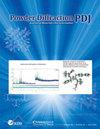使用虚拟现实环境评估PZT结构的压力依赖性
IF 0.4
4区 材料科学
Q4 MATERIALS SCIENCE, CHARACTERIZATION & TESTING
引用次数: 0
摘要
Pb-Zr-Ti-O (PZT)钙钛矿具有广泛的固溶范围,由于其压电和铁电性质也具有广泛的应用范围。通过Rietveld细化的晶体结构分析,通过提取结构参数,便于材料分析。这些参数通常作为附加维度(例如压力)的函数获得,可以帮助诊断材料在使用环境中的响应。这些实验通常被称为“原位”研究,提供了大量的数据。观察由于施加压力条件引起的结构变化可以为材料性能提供急需的洞察力。然而,当细节本质上是三维(3D)时,观看/呈现结果存在挑战。对于PZT钙钛矿,使用多面体(例如,Zr/ Ti-O6八面体)来观察键合/连通性是有益的;然而,由于附加压力维度的复杂性,八面体的压力依赖行为的可视化不太容易展示。我们通过将结构数据投影到虚拟现实(VR)中来呈现更直观的可视化。我们采用先前发表的Pb0.99(Zr0.95Ti0.05)0.98Nb0.02O3的结构数据作为PZT R3c晶体结构在环境和0.62 GPa压力下的VR可视化示例。这是通过我们内部的CAD2VR™软件平台和新的CrystalVR插件完成的。VR环境的使用可以提供更直观的观看体验,同时可以对晶体数据进行实时评估,形成对原位数据集的详细和全面的了解。讨论了观看的方法和工具,以及如何以视频形式记录结果可以使观看体验。本文章由计算机程序翻译,如有差异,请以英文原文为准。
Evaluating the pressure dependence of PZT structures using a virtual reality environment
Pb–Zr–Ti–O (PZT) perovskites span a large solid-solution range and have found widespread use due to their piezoelectric and ferroelectric properties that also span a large range. Crystal structure analysis via Rietveld refinement facilitates materials analysis via the extraction of the structural parameters. These parameters, often obtained as a function of an additional dimension (e.g., pressure), can help to diagnose materials response within a use environment. Often referred to as “in-situ” studies, these experiments provide an abundance of data. Viewing structural changes due to applied pressure conditions can give much-needed insight into materials performance. However, challenges exist for viewing/presenting results when the details are inherently three-dimensional (3D) in nature. For PZT perovskites, the use of polyhedra (e.g., Zr/Ti–O6 octahedra) to view bonding/connectivity is beneficial; however, the visualization of the octahedra behavior with pressure dependence is less easily demonstrated due to the complexity of the added pressure dimension. We present a more intuitive visualization by projecting structural data into virtual reality (VR). We employ previously published structural data for Pb0.99(Zr0.95Ti0.05)0.98Nb0.02O3 as an exemplar for VR visualization of the PZT R3c crystal structure between ambient and 0.62 GPa pressure. This is accomplished via our in-house CAD2VR™ software platform and the new CrystalVR plugin. The use of the VR environment enables a more intuitive viewing experience, while enabling on-the-fly evaluation of crystal data, to form a detailed and comprehensive understanding of in-situ datasets. Discussion of methodology and tools for viewing are given, along with how recording results in video form can enable the viewing experience.
求助全文
通过发布文献求助,成功后即可免费获取论文全文。
去求助
来源期刊

Powder Diffraction
工程技术-材料科学:表征与测试
CiteScore
0.90
自引率
0.00%
发文量
50
审稿时长
>12 weeks
期刊介绍:
Powder Diffraction is a quarterly journal publishing articles, both experimental and theoretical, on the use of powder diffraction and related techniques for the characterization of crystalline materials. It is published by Cambridge University Press (CUP) for the International Centre for Diffraction Data (ICDD).
 求助内容:
求助内容: 应助结果提醒方式:
应助结果提醒方式:


